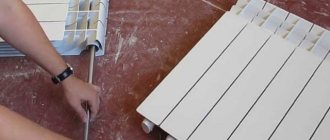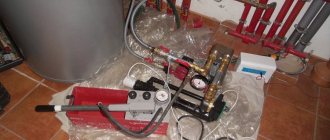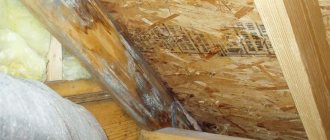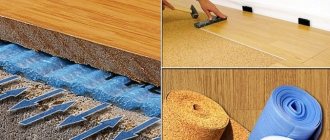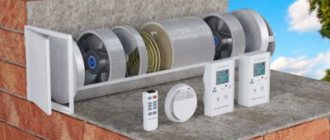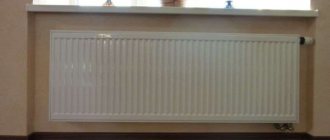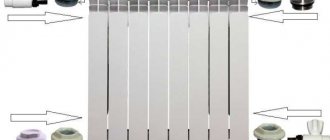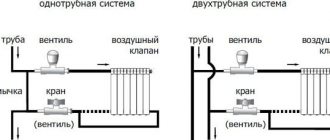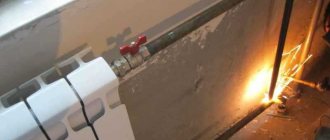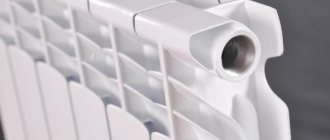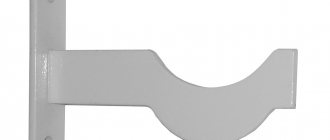How to disassemble a cast iron radiator
The joints of the old battery are quite strong. In many cases, they “grow together” in such a way that strength alone is not enough. Therefore, before disassembling the battery, it should be placed on boards and properly prepared.
The simplest preparation involves heating the joint. To do this, use a hair dryer or a blowtorch. The latter can burn old paint. However, it's not scary.
More serious preparation involves heating the metal to such an extent that it begins to glow. After this they try to unscrew the nipple. This can be done both when the alloy becomes very hot, and when it has cooled noticeably. The second option is even better, because during cooling the gasket becomes covered with cracks and the strength of the connection becomes weak. He is often shown in videos.
To disassemble a battery made of cast iron, you need to perform the following steps:
- Unscrew the plugs (plugs).
- Place the radiator key on top of the device so that the flattened end rests on the nipple. Make a mark on the key where the battery ends using chalk or electrical tape.
- Insert the key inside the bottom hole.
- Turning it along the axis to the right and left, insert it into the product up to the drawn mark.
- Determine which way the nipple is screwed. To do this, bait it with the right and left sides. If you manage to bait it with the right side, then you need to unscrew it counterclockwise.
- If you manage to move the nipple, then make one revolution. Next, a similar procedure is done with the nipple at the other end of the section.
- Both nipple nuts are unscrewed in turn. Otherwise the section will crack.
- In the same way, you need to unscrew all sections.
If it was not possible to disassemble the heating battery in this way, you will have to saw through the section that is leaking. At the same time, they saw it in the center of the nipple. The work is carried out by picking up a grinder or a hacksaw.
Another option is to break the bad section with a sledgehammer. You need to break the middle part of the section. The nipple, which remains unharmed, is unscrewed using a plumbing wrench. It can also be knocked out using a hammer and chisel. Then you need to clean the threads in entire sections.
Individual and centralized battery cleaning
There are two ways to wash heating batteries: centralized and individual washing. Individual flushing is the only option for flushing radiators in apartments and private houses where autonomous heating is installed. In order to flush, you will need to remove and then reinstall the heating radiator. The main advantage of the individual method is minimal costs.
The second method is used only for heating radiators installed in apartment buildings. In order to flush the radiator, it is necessary to agree with all neighbors, and there will also be costs involved. But in the centralized method there is no need to remove the heating battery. Radiators are flushed using special equipment. This procedure can be carried out by specialized construction companies or utility services. For this method, the hydropneumatic flushing method is used. In this method, the principle of operation is as follows: under pressure, water is supplied to the riser together with air. Air enters as the compressor operates periodically and thus water and air are mixed. Particles of debris that have accumulated on the internal channels of heating batteries are fought off with the help of air bubbles.
This method perfectly washes away dirt. But to carry out centralized flushing, a lot of effort is required to gather the consent of all residents of the house. Therefore, many prefer an individual method, in which you simply need to remove the heating battery. This method does not require any costs and is quite fast.
Tools for disassembling a cast iron device
Their list consists of:
- Radiator key.
- Chisels.
- Hammer.
- A small sledgehammer.
- Brushes with metal bristles.
- Blowtorch.
- Plumbing wrench No. 2,3. They need to unscrew the side plugs or plugs.
In many cases there is no radiator key. The situation is complicated by the fact that it is almost impossible to find in construction stores. Of course, it exists in the markets. Also, plumbers must have such a key.
The key itself is a round metal bar. which is 18 mm in diameter. One end is flattened and resembles a spatula. It has dimensions 28x40 mm. Thickness 6 mm. At the other end there is a welded ring. You need to insert a lever into it. As for the length of the key, it should exceed half the length of the radiator by 30 cm.
You also need to prepare several boards. Chocks may be suitable instead. They will be fitted with a battery before disassembly.
How to wash cast iron radiators
The efficiency of cast iron heating radiators and the reduction in their heat transfer depends on many factors, including the cleanliness of the internal cavities. The high temperature of the coolant contributes to the accumulation of scale on the walls of the sections. Periodic draining and refilling can cause radiators to dry out, which leads to corrosion. Particles of scale, rust, and other mechanical impurities that get inside due to poor water filtration mix with the coolant and clog the batteries and pipes. As a result, the quality of heating decreases and fuel consumption increases.
Periodically washing cast iron batteries with your own hands helps to cope with this problem. You can really do this work yourself, without resorting to the help of any companies. You should prepare for cleaning and follow the sequence.
Signs by which you can understand that it is time to clean your heating appliances:
- Uneven heating of the radiator. At normal pressure and temperature in the network, without airing, the top of the battery is hot and the bottom is cold. Or vice versa. And also with hot supply pipes, the radiators are barely warm.
- The heating system takes longer to warm up than usual.
- A clear symptom of the presence of large contaminants in the battery is an increase in energy consumption.
In what cases may radiator flushing be necessary?
There are several main conditions under which battery flushing is necessary:
- Uneven heating of the radiator. In this case, on one side the device heats up more than on the other.
- It takes longer for the battery to fully heat up than before.
- Heating radiators do not heat up, despite the fact that the pipes leading to them are hot.
- Fuel consumption for heating the house has increased.
In most cases, either cast iron or bimetallic radiators are installed in modern houses. The latter have higher performance characteristics because they have a smooth surface and clog much more slowly.
In general, the method of cleaning batteries does not depend on the material they are made of. However, when deciding how to wash bimetallic batteries, it is worth choosing the chemical method rather than the mechanical one.
Flushing heating systems in a private home
In private homes, especially those located outside the city, the problem of cleaning the heating system is more acute. This is due to the fact that the water circulating in the system is taken from wells and reservoirs where it is not purified. Thus, much more sludge and other small fractions accumulate in heating radiators, polluting the pipeline. In this case, it is much more advisable to clean the entire heating system rather than individual radiators.
Flushing of cast iron pipelines is carried out in the summer, but not during the heating season! Before starting cleaning, you must open all valves to bleed air from the batteries. This procedure is best done by a practicing master plumber. This work requires care to avoid a flood and damage to the equipment.
There is no need to release water from the boiler; the steam line is closed during cleaning. When the air is released and the corresponding valves are closed, then water is released throughout the entire heating system. Water should be supplied until clear water flows from the heating pipes.
For better cleaning, you can add cleaning agents to the pipelines: soda ash, whey, vinegar. You can use chemical compounds: car radiator cleaner or concentrated “Mole” alkali.
After using chemical compounds, the pipelines must be thoroughly washed. To do this, heat the boiler and run hot water through the system, which will wash away any remaining rust, oil stains and cleaning agent residues.
The system flushing procedure must be carried out 1-3 times a year. This will depend on the purity of the water supplied to the pipelines.
It is important to note that after the heating season there is no need to release water from the system. This is due to the fact that empty radiators are more susceptible to corrosion than those filled with water.
During the summer, the water in the pipes also rusts and therefore, before the next heating season, it is necessary to drain the rusty water and flush the system with the addition of bleach.
Washing radiators outside
In addition to internal contaminants, heating radiators often contain dirt from the outside. This does not harm their main function - heating the room - as much as internal pollution, but it significantly spoils their appearance. In addition, things are often dried on radiators, so ideally radiators should be absolutely clean and free of dirt and dust on their surface.
Detecting this kind of pollution is very simple - they are visible to the naked eye. You should not put off external cleaning of batteries until later, because removing light and fresh dirt is much easier and faster than old dirt.
What you need to clean the outside of batteries
To clean the outside of radiators, you will need the following things:
- vacuum cleaner;
- a hair dryer, preferably with a narrow nozzle that allows you to produce a targeted narrow stream of hot air;
- soft brush for removing dust or pipidastra;
- foam sponges;
- soft rags that do not leave scratches on the painted surface;
- dish brushes;
- detergent.
Methods for cleaning batteries externally
In addition to internal cleaning, many people are interested in the question of how to wash radiators outside. Many housewives, when performing regular cleaning, neglect to wash the batteries, leaving dust and even dirt on them, which immediately reveals a careless attitude to order. Perfect cleanliness consists of small details like these. In addition, batteries should be especially clean if children live in the house.
You can clean the outer part of heating radiators using several methods: dry and wet, as well as using steam.
Dry cleaning method
The dry method is used when a layer of dust appears on the radiators, but there are no greasy or other contaminants, obvious stains or streaks. It is recommended to carry it out regularly once every 7-10 days. It is done quite simply:
- The main layer of dust is brushed off with a brush.
- A vacuum cleaner with a narrow nozzle attached to it removes dust from the rear, hard-to-reach surfaces of the radiator.
- A household hairdryer will help blow away dust even faster and more efficiently, especially helping with those areas that cannot be cleaned with a brush or vacuum cleaner.
- The radiator is wiped with a soft, dry cloth.
Cleaning batteries with steam
Close to the dry method in purpose, but cleaning batteries with steam is more effective. It also helps remove dust and light dirt. The best option in this case would be to use a steam generator. A directed flow of hot steam will help solve the following problems:
- Cleaning batteries from dust. The steam will remove its deposits, after which it will be enough to walk over the battery with a dry soft cloth. This device is able to remove all contaminants even from the most inaccessible areas.
- Dissolving small old stains. If there are small stains on the radiator, the steam will help dissolve them without washing with water and detergent.
- Disinfection. This is especially true if the battery is used to dry things.
It is worth noting that exposure to steam can damage the paint on the radiator, especially if it was applied in one or two layers and has not been updated for a long time. The method should be used with caution and not direct steam to one area for too long.
For steam cleaning, you can also use a clothes steamer if you don’t have a steam generator at home. However, it is less effective in this case, since the steam from it is supplied under much weaker pressure and less targeted.
When to clean heating radiators
The main indicator of comfort level is the room temperature. According to established standards, its minimum value for apartments and residential buildings is 18°C, but many begin to feel comfortable only when this indicator reaches 21°C, or maybe even higher. What to do if the temperature in the apartment is below the established standards, and representatives of utility services claim that they supply heat in full. Most likely, this is the case; the radiators in your apartment are simply clogged - a problem that occurs quite often. The following factors indicate that your radiators require flushing:
- when testing the heating riser, you suddenly discover that its temperature is much higher than the temperature of the heating radiators;
- in one room the radiators work at maximum efficiency, while in another they are barely warm or do not heat at all;
- it’s warm in your neighbors’ apartment, but you keep complaining about the quality of heating in your apartment;
- the heating radiator in its upper part is slightly warm, and its bottom is cold;
- Radiator sections do not warm up equally.
If at least one of these symptoms is detected, then it is necessary to begin “treating” your radiators.
This can be done in different ways, but it must be done, since you will still have to pay for heating. And what to pay for, you ask yourself a completely logical question. Thus, without delaying it, the problem must be solved. If you do not yet know how to flush a heating radiator, we recommend that you talk to specialists or carefully read these instructions.
Pneumopulse radiator cleaning
Causes of contamination of heating devices
There are several reasons that determine the need to flush heating radiators:
- uneven heating of the heat exchanger - the lower part is cold and the upper part is hot or vice versa;
- reduction in the rate of heating of the radiator compared to previous heating seasons;
- the heating main is hot, while the radiators themselves are cold;
- increase in energy consumption at a constant coolant temperature.
Currently, apartment and house owners prefer bimetallic and cast iron radiators. Bimetal, compared to other materials, is the most inexpensive, but quite effective. Cast iron is more of a tribute to tradition, although such radiators today are designed in different styles, which is why it becomes almost an independent element of the interior.
We disassemble and clean the cast iron battery
A cast iron radiator is a heating device that over time can lose its thermal power due to dirt that floats along with the coolant and remains inside the sections. In addition, gaskets may be destroyed. And this results in the destruction of the paint layer and leakage of the heating device.
In the first case, it is enough to remove the radiator and clean or rinse it. Otherwise, in addition to cleaning, it still needs to be disassembled. If the heating battery is relatively new, then there should not be any difficulties in disassembling it. However, if there is a device in the house that is 40 years old or more, then disassembling it will be accompanied by problems. After all, for a long time:
- The joints of the sections “grow together”.
- The internal protrusions of the nipple are corroded by the coolant.
True, the situation is somewhat simplified by the fact that once upon a time, for a better connection, tow with paint was wound around the nipple. Thanks to this, the tow prevents the section from merging with the nipple. A rubber gasket was always placed at the joint formed by the sections. In many cases, it is its drying out and covering with cracks, as well as subsequent destruction, that causes water leakage, which deteriorates the appearance of the paint.
Washing methods
There are two ways to clean the internal surface of batteries: mechanical and chemical.
Chemical cleaning methods include household cleaning products that have a chemical effect on contaminants. Such substances are:
- lemon acid;
- household chemicals containing caustic soda;
- means for cleaning car radiators.
All the substances described above clean well, for example, cast iron radiators, but with varying effectiveness.
The product for car radiators is considered the most effective, but it is not cheap. Acetic acid removes contaminants in the form of salt deposits. But if there is a fairly large layer of deposits in the batteries, then with such a product you will not be able to completely get rid of it.
Citric acid copes much better with complex stains.
The mechanical method includes flushing the heating system by tapping the radiator body. This way the plaque will peel off from the surface.
Clean the batteries at the end of the heating season.
In order to perform the best possible cleaning of batteries, you should:
- First of all, unscrew all the plugs, insert the supplied hose into each hole one by one and rinse the radiator with water.
- After all three holes are plugged, you need to add dishwashing detergent to the water through the fourth. The remaining hole must be closed and the radiator itself must be moved. Caustic will dissolve organic pollutants and with the help of citric acid it will be possible to get rid of salt deposits.
- At the next stage, you need to unscrew the plugs, drain all the liquid and add water with dissolved citric acid. After which all holes are closed for several hours.
- When the specified time has passed, the water must be drained.
Thus, by following all the above steps, you can clean the batteries well.
Cleaning batteries using special equipment
Cleaning cast iron batteries without removing them can be done using special equipment. The following complex equipment is intended for domestic needs:
- pneumatic pistol "Typhoon";
- device for electrohydropulse influence ZEVS-24;
- cleaning device Krot-Mini.
Air pistol "Typhoon"
Flushing the battery with a Typhoon pneumatic gun
The equipment is compact and easy to use. It is used to perform targeted impact on blockages in water and sewer pipes with a diameter of up to 150 mm. The essence of the process is a hydraulic ram to remove hardened deposits from the walls of equipment and adjacent risers with a shock wave at a speed of 1.5 km/h, which spreads over a distance of up to 60 meters.
Pneumatic pistol "Typhoon" in action
This cleaning of the heating system allows you to completely remove contaminants that are not amenable to conventional hydraulic flushing.
"Typhoon" is indispensable as a plumber's tool for clearing blockages in various hard-to-reach places. Depending on the configuration and weight, the device has 6 modifications and the following indicators:
- internal cleaning diameter up to 150 mm;
- maximum firing range to the target is 60 m;
- special valve design for kinetic ramming;
- pressure gauge on the body;
- Possibility of manual inflation.
Comprehensive flushing of heating batteries
As a rule, “Typhoon” is used in conjunction with the ZEVS-24 automatic installation and the Krot-Mini device for cleaning hard-to-reach objects.
Installation ZEUS-24
ZEUS-24 has small dimensions and sufficient power to destroy hardened heating devices, internal and external water supply and sewerage networks that are firmly stuck to the inner walls. The essence of its work is based on the electrohydropulse effect on solid contaminants in pipes with a diameter of 7 to 150 mm. The electrical discharge created by the device leads to the generation of a shock wave and powerful hydrodynamic flows that act on hardened clogs, scale and deposits.
Procedure for hydropneumatic flushing of heating radiators (batteries)
- destruction of blockages of any strength;
- safety of the equipment being cleaned;
- cleaning of hard-to-reach bent and spiral pipes;
- wear resistance of manufacturing materials;
- protective shutdown on the plug.
Krot-Mini device
The device has the following advantages:
- ability to work with various drums and spirals with a diameter of 6 to 13 mm;
- easy drum replacement procedure;
- to facilitate work, the distribution pipe is located inside the drum;
- automatic spiral feed;
- durable and flexible spiral made of hardened steel cable, entwined with hardened steel wire;
- high torque allows you to remove stubborn dirt;
- standard equipment consists of 4 different nozzles, allowing for complete cleaning of pipes and removal of foreign objects;
- For use in wet rooms, the device is equipped with an RCD.
Flushing heating batteries with the Krot-Mini device
How to ensure warmth and comfort in your home depends on everyone’s choice and preferences. You can extend the life of old equipment or replace it with new, more modern one.
Cleaning methods
At the moment, there are several methods by which you can clean cast iron batteries from contaminants. Some craftsmen do all the work at home, while others prefer to turn to heating network workers for help.
We recommend: A stove being used in a garage: pros and cons, drawings, how to make it yourself, video
Each washing option has its own characteristics.
Dry cleaning
Dry cleaning involves everyday cleaning. Cleaning the outside of the battery is not difficult if you do it once a day or at least once a week.
Cleaning heating radiators from the outside:
- The vacuum cleaner comes with special attachments that can remove all the dust between sections if they are very close to each other.
- If you don't have a vacuum cleaner, you can use a hairdryer. We attach a damp cloth between the heating radiator and the wall. We direct the flow of hot air inside the sections and blow out all the accumulated dust. Thanks to the damp cloth, the dirt will not fall onto the carpet, but will stick to the rag. Then we rinse the cloth in clean water and continue cleaning other devices.
You can buy a special brush for heating radiators in the store. It will be easier for her to wipe off dirt. It is equipped with soft sponges that are very dense and allow you to clean the battery from several sides at once.
Wet cleaning
Use any detergent that can be used to clean the outside of a cast iron radiator.
Mix some liquid in a bucket of hot water, whip up foam. Dip the sponge and squeeze out excess water. Wipe the outside of the radiator, and don't forget about the piping and valves.
The wall behind the heating device can also be washed with soapy water.
Mechanical
For such cleaning, the pipes are disassembled. It effectively removes accumulated dirt, but is weakly effective against scale on the internal surfaces of the circuit. Before such flushing, close the valves before and after the boiler, then drain the water from the circuit using a drain valve. If it is not there, unscrew the cap on the radiator, which is located lower and farthest in the apartment. For greater efficiency, after draining the water, the batteries are dismantled.
To disassemble the radiator, use wrenches of the required size, including pipe wrenches. To do this, loosen the union nuts that connect the radiator to the pipes. The radiator is taken outside or into the bathtub, first covering it with thick textiles that protect it from mechanical damage. After washing, the textiles are discarded. The drain in the bathtub is covered with a mesh to prevent clogging of the sewer.
They clean the radiator with a cable and use it to clean the pipes. You can remove the primary dirt into a previously prepared container to reduce the load on the sewage system. For greater efficiency, before flushing, you can disassemble the radiator into sections of 2-3. After cleaning, the battery is washed by directing a stream of water into the internal circuit. To do this, use a hose with an adapter, ensuring the tightness of the hose connection. Stop washing when the outlet water becomes clear.
Dispersed
Biological flushing is an improved modification of the chemical method for removing clogged radiators. However, the action of the reagent here is somewhat different from the original method. The diluted reagent entering the system does not destroy the structure of metal radiators: its action is aimed at molecular rupture of the compounds of metal and compressed dirt. This method is applicable to batteries made of different materials, which is convenient and does not cause leakage.
The solutions used are not harmful to humans, so there are no problems with the disposal of waste material. During the washing process, dirt comes out of the batteries in a split form, so its pieces do not clog the radiator and pipe passages. After treatment, a special hydrophobic film is formed on the surface, which prevents the formation of new limescale deposits inside the circuit.
The process is carried out as follows:
- calculate the amount of reagent based on the characteristics of heating systems;
- prepare the device as in the chemical method;
- the device is connected to the system, the pump is turned on, liquid is introduced into the system circuit;
- after the required time, the waste material is drained into the sewer;
- flush the system with water several times;
- the system is filled with clean water.
When performing flushing during the heating season, you need to connect a device that closes the heating system.
Hydrodynamic
This technique involves supplying thin jets of water under high pressure to the heating system. Special nozzles are used for it. Water will not be supplied from a tap using a hose, but through a pump under pressure. Using this method, it is possible to stop the supply hose in particularly problematic areas where flushing is required. The method is considered environmentally friendly and effective for cast iron radiators.
However, it is not so easy to do it at home, because equipment that can provide water pressure of several hundred atmospheres is not cheap. In addition, such washing requires experience, which may require calling a specialist. Another disadvantage is the fact that the deposits must first be softened with a special solution, which is different for each battery material.
Hydropneumatic
This method involves flushing the heating system by supplying high pressure air inside the circuit. It is carried out through the inlet or outlet of one of the radiators, using a compressor, which is connected through a check valve. This connection prevents water from entering the system. The compressor supplies steam, creating a turbulent flow with high energy. This causes the build-up of compressed rust inside the circuit to be torn off and washed out of the system.
To flush radiators in this way, turn off the water. After this, a compressor with a pneumatic gun is connected to the radiator. When the batteries are not dismantled, the cap on the farthest one is unscrewed and a hose is connected through an adapter, which will collect debris. He is taken to the toilet. The first air supply, which is a short-term pulse, is carried out in the direction opposite to the circulation flow of the system.
Re-injection is performed by changing the direction of the air. To do this, the supply and collection hoses are swapped. To make the method more effective, you can dismantle the radiator, although this is more troublesome. The batteries can be taken outside, where it will be easier to wash them. After washing, they are put in place, then the circuit is connected to the coolant and the system is started to wash out any remaining dirt.
Then turn off the water supply, remove the drain hose, and put the plug in place. Now the system can be put into operation. The method is based on shock waves, of which a total of 2 to 5 may be needed. This flushing method does not take more than a few minutes if the radiators are not removed. It does not depend on electricity, since the installation operates autonomously. Its disadvantage is the limited range of action, which depends on the technical characteristics of the air gun used.
Electrohydropulse
This cleaning is carried out using electric discharge energy, which destroys scale and salts deposited inside the circuit. However, the batteries and pipes are not damaged. This method requires special equipment, although its efficiency is high, and the process itself does not require disassembling the heating system. The shock wave will destroy existing scale. And after the process, all that remains is to rinse the system with clean water to get rid of deposits that have lagged behind the walls.
This method is an alternative to replacing batteries. It is based on the application of an electrical charge in water and does not require a large amount of energy. After using a special installation, the heat exchange surfaces are completely cleaned of silt and lime deposits, which increases the internal cross-section of the circuit to the factory size. In this case, you can clean radiators and pipes of any configuration. A coaxial cable with special equipment at the end is placed into the pipe. During operation, periodic electrical discharges are created, which creates powerful waves and hydrodynamic flows, due to which effective cleansing occurs.
We recommend: Calculation of an expansion tank for closed and open heating
Chemical
If you wish, you can clear communications yourself. But this is quite labor-intensive work, the complexity of which is determined, first of all, by the weight of the heating equipment.
During work using the chemical cleaning method, there is no need to violate the integrity of the system - disassemble the batteries into sections. It is most suitable when communications are installed in an autonomous heating system, that is, a private house, cottage or apartment.
The cleaning of cast iron heating radiators itself is carried out using chemical elements - reagents that are sold in many stores. If desired, improvised means can be used, for example, soda ash or caustic soda.
Cast iron radiators can also be washed with composite solutions, alkalis, organic and mineral acids in small proportions. Each container of chemicals has clear instructions to follow during cleaning. The fact is that these elements, with which batteries are cleaned, are aggressive substances. They affect not only scale and deposits, but also the material from which the radiator is made.
To extend the service life of the equipment, it is enough to clean it once every 3-4 years.
Often, when washing on their own, users make a serious mistake - they prepare an acid solution that is too concentrated. A large concentration of the washing solution will easily “eat up” the contaminants, and with them the sealing elements of the device. This may cause the batteries to leak. Chemical liquids should under no circumstances be used to clean aluminum radiators, unless it is a specially designed preparation.
If you lack skills, it is not recommended to carry out the work yourself, otherwise there is a possibility of permanently damaging the equipment. It is best to turn to specialists who have everything you need.
If you still want to do the cleaning yourself, it is not recommended to use too strong substances.
The best options are the salt of ethylenediaminetetraacetic acid or a more gentle option in the form of citric acid.
Hydrogen peroxide
A good helper in the household is 3% hydrogen peroxide. This well-known substance perfectly cleans and disinfects batteries. To use, add ¾ of a bottle to 2-3 liters of water. To remove severe stains, you can use pure peroxide by applying the substance directly to the stained area or with a sponge.
Lemon acid
Using citric acid, you can not only effectively clean the radiator from contamination, but also get rid of the unpleasant odor. As a rule, the smell appears from stagnant water and flower fertilizer that has reached the surface of the radiator. To prepare a cleaning solution, you will need to dissolve 3 tsp in a glass of water. citric acid.
Baking soda
Regular baking soda is suitable for cleaning the battery. To do this, dissolve 2 tbsp in 3 liters of water. l. soda For greater effect, you can add 1 tsp. apple cider vinegar and 7 drops of any liquid soap.
Vinegar 9%
Vinegar is poured into a spray bottle for further spraying onto the stained area, previously cleaned with a damp cloth. Afterwards, the battery must be thoroughly rinsed with water and wiped. Vinegar essence mixed with water in a ratio of 1:10 can also be used. When spraying in the room, the windows should be open; it is better to protect the respiratory tract with a mask.
Use of special compounds
Effortlessly, in just a few minutes, special cleaning products will help remove dirt and grease stains. To remove greasy stains, you can use dishwashing detergents, for example, Fairy, Pemolux, MYTH. Before use, it is necessary to dilute the concentrate in water, foam it and wipe the surfaces of the radiator with a brush or sponge. Light stains can be removed with laundry soap. Complex contaminants can be removed using special household chemicals intended for plumbing fixtures and household appliances, for example, Domestos, Krot, Tiret. Old stains are removed using stain removers, for example, “Vanish” and “Antipyatin”.
Using special equipment
At the moment, there are several types of special equipment used for cleaning batteries.
For domestic purposes this is the following equipment:
- pneumatic pistol "Typhoon";
- device for electrohydropulse influence ZEVS-24;
- Krot-Mini device.
Typhoon
The air gun is a compact and easy-to-use device. Thanks to its targeted effect on blockages, it can clean water and sewer pipes with a diameter of no more than 150 mm.
The essence of cleaning is a hydraulic ram, which, moving at a speed of 1.5 km/h, removes hardened deposits from the walls of the equipment. The maximum distance of the shock wave reaches 60 meters. The use of a pneumatic gun is important if conventional hydraulic flushing does not produce results.
ZEUS-24
Despite its small size, this equipment is powerful enough to destroy hardened deposits firmly stuck to the inner walls of pipes. It can be used to clean products with a diameter of seven to 150 mm.
The working principle is as follows: the device creates an electrical discharge, resulting in a shock wave and powerful hydrodynamic flows. The ZEUS-24 installation allows you to clean hard-to-reach bent and spiral pipes.
Mole Mini
This installation cleans communications with a diameter of 20 to 150 mm - intra-house sewer networks and other pipelines. Thanks to the spiral installed in the drum, cleaning hard-to-reach places is easier.
The device is used in many sectors of human activity: from housing and communal services, hotels, gas stations to industrial enterprises.
Electrical appliances
Thorough cleaning of the battery can be done using electrical appliances. It is important to take precautions.
Vacuum cleaner
You can use a vacuum cleaner for cleaning. It is advisable to use a narrow nozzle, this will allow you to penetrate hard-to-reach places. First you need to remove all dust and debris from the inside, then treat the outside. When finished, you can wipe the radiator with a damp cloth.
Hairdryer
To use a hair dryer, you must first place a towel or any thick cloth soaked in water under the radiator. Direct a stream of hot air onto the radiator. The dust will move from the battery to the damp cloth. Not the most effective way: dirt can remain between the sections, get into the air or walls, floor.
Washing vacuum cleaner
A good alternative to a regular vacuum cleaner. It will cope perfectly even with serious dirt. Cleaning should begin from the inside, and then proceed to the outer surface. A washing vacuum cleaner, thanks to an aqua filter, can prevent the spread of dust throughout the room.
How to wash cast iron radiators and chemistry will help us again
What is the cause of battery contamination? Over time, the quality of water leads to a lot of mechanical particles settling in heating systems. A very small wire, etc., moves along the heating risers simultaneously with the water. During the non-heating season, water is drained in most cases. This leads to pockets of rust appearing in the pipes.
Supplying hot water under pressure exfoliates rust particles, and they also settle on the batteries. And the water itself, released into the heating system, is very often not considered clean. This accumulation of very different debris in cast iron heating systems leads to the fact that for years they eat up the rust waste circulating through the system and the battery becomes clogged.
Over time, this affects the quality of heating. Even with very good heating of cast iron pipes, they can only be warm or slightly warm, although the riser itself is hot. If this happens, it is a sure sign that the heating system is clogged and needs to be cleaned.
Do-it-yourself cleaning, cleaning, and flushing of cast iron batteries and radiators
Since this difficulty does not bypass any person, let’s look at how to clean cast iron radiators
If you don't take into account the weight of the object, the cleaning job is far from difficult. There are several options for how to clean heating systems.
From the following you can choose the ideal option for yourself.
You can clean the battery from debris using soda ash, car heater cleaners, whey, vinegar essence and many other options.
Cleaning cast iron batteries begins with dismantling them. However, if they do not have many layers of paint, they can be disassembled into very small parts to make them easier to handle. This procedure should be done during the season when the apartment is not heated.
One option is to pour ordinary soda ash into hot water and pour it into the heating system. In this case, plugs should be installed at both ends of the heating system. The battery can be shaken and after a short time, approximately one hour, knocked around the perimeter with a wood hammer so that the corrosion adhering to the walls is released.
Next, open one plug and connect the hose, previously combined with the water meter unit. Open the second plug and open the tap. We immediately apply high pressure so that under pressure more rust comes out of the battery. If you have an air blower at your disposal, you can use it to create more pressure.
Washing cast iron batteries can be done with a product prepared for washing a car heater. Before pouring the product into the heating system, read the instructions for the dosage for a specific volume and follow it.
So, the product is poured in and hot water is added, but the battery is not completely filled. For 2 hours, parts of the battery must be moved at intervals of 10 minutes. At the end of this time, the heating device is washed with strong water and in large quantities so that no corrosive particles remain.
How to clean a cast iron battery with whey? The serum is poured into the battery and, as with soda ash cleaning, the heating system is tapped and turned over to agitate the serum. The acid contained in the serum will eat away the rust and cleanse your heating system of it.
In order to reduce the amount of rust on batteries in the future, you can remove a small tip of the pipe with a plug in front of the inlet hole and attach magnets to it. The magnet will attract rust, and all that remains is to occasionally open the plug at the end of the pipe to remove corrosive particles.
The main causes of malfunctions of cast iron radiators
Cast iron is highly durable, the service life of heating products is 25–30 years , under optimal conditions - 50 years or longer.
But thick-walled cast iron batteries have vulnerabilities: most often radiators leak between sections, at connections with pipes, and sometimes fistulas and cracks appear on the cast iron itself.
The main reasons why repairs have to be carried out:
- Heavy weight. Depending on the type and manufacturer, the weight of one cast iron section is 4.5–7.1 kg, the filling volume is 1–4 liters , the standard set consists of 4–10 elements. In case of unskilled installation and incorrect calculation of the number of brackets, the radiator becomes skewed. As a result, the joining elements suffer and metal fatigue occurs. In places where there is no coolant, corrosion appears, then a fistula.
- Instability to water hammer and high pressure. When an obstacle is abruptly removed, the liquid acquires enormous speed and rushes to the area of lowest pressure. The power of the water hammer in the heating circuit exceeds the force of a hammer blow. A sudden change in pressure or its high levels threaten depressurization of the heating system - leaks most often occur at the joints where parts of the radiator are connected.
- Dirt and trash. Elements of domestic cast iron batteries are produced by casting. The technology is such that the surface remains rough, which is excluded in imported analogues.
Due to the granularity, particles of rust and suspension that fill the coolant settle on the walls. Gradually, the channels become clogged and cannot withstand the pressure of water - the battery may burst from pressure or water hammer. To prevent repairs, regular flushing of the system is required.
Photo 1. The elements of the cast iron battery are clogged with rust and debris; because of this, the radiator cannot cope with the water pressure.
- Wear of intersection gaskets. The strength of collapsible joints is always inferior to monolithic structures. Intersectional gaskets and threaded battery nipples wear out faster than cast iron and are more susceptible to temperature and pressure. To avoid leaks and emergency repairs, do not forget about prevention: after the heating season, check the connections and change the gaskets.
Tools and materials for eliminating defects with your own hands
Minor repairs of cast iron radiators are possible without the involvement of master plumbers , with your own hands. Depending on the method of restoration work, you will need:
- metal cable or sandpaper - to clean the defect area ;
- for repairing section joints: clamp - a fastener consisting of two rubberized plates from the inside, connected by bolts;
- to eliminate fistulas: cold welding for radiators - a plastic mass intended for fixing metal parts without thermal heating;
- degreasing solvent: gasoline, acetone, white spirit and others;
- one of the sealants: iron powder, polymer, cold welding, epoxy resin;
- bandage or strips of fabric;
- a wrench to match the size of the clamp fasteners, pliers;
- rags, oilcloth, container for collecting water.
Signs of contamination of a cast iron battery
Since after the end of the heating season the water is drained from the system, and it remains dry all summer, this causes the formation of corrosion even in the most resistant metal. For many years, small rust formations do not cause harm to the heating network and its elements, but over time, the layers of rust become thicker, changing the quality and efficiency of radiators.
You can notice that cast iron batteries require flushing based on several signs:
- If during the heating season it is discovered that one of the sections or the entire radiator is colder than the rest of the devices, then this is a clear sign that the channels in it are littered or narrowed by a coating of rust.
- When the temperature of the riser exceeds the heating of the battery, this is another sign that the hot water is not entering it in full.
- If the radiators throughout the apartment are slightly warm, you should not immediately scold the “careless” heating network workers. You need to find out from your neighbors how hot their batteries are. If their apartment is warm, then you should think about how to wash cast-iron radiators in the operating conditions of the heating network.
- Another clear sign of a blockage may be uneven heating of the battery. If this is not an air lock, which is easy to check by opening the Mayevsky tap, then it means scale or debris.
- It happens that in one radiator one section is colder than the other. This means that the channel in this place is clogged. Since flushing cast iron radiators in individual sections is impossible, the entire structure will have to be dismantled.
These are the main signs that your batteries need cleaning. In order not to take matters to such extremes, it is better to carry out preventive flushing of heaters, although sometimes you can entrust this process to heating network workers before the start of a new heating season.
Why do the internal channels of cast iron batteries become dirty?
Typically, in a centralized heating system, the quality of the coolant leaves much to be desired. This is due to the fact that the quality of the coolant is poorly controlled. As water moves through the system, it carries particles of various impurities. Many pipes have not been replaced for many years, and corrosion forms inside them. Small pieces of rust, under the influence of the pressure of hot water, come off and move through the heating system, and then enter the radiators. In them they settle on the walls. Due to rust, debris and impurities, the internal channels of the heating radiator become clogged. Consequently, the amount of coolant decreases and heat transfer decreases. Even if you use high-quality water heating, it will still not create a comfortable temperature in the room. Therefore, it is necessary to flush the radiators.
Washing with soda ash and whey
According to videos filmed by various experts, cleaning with soda ash is carried out as follows:
- Plugs (plugs) are placed on the two holes of the outer section.
- Soda ash is diluted in hot water. Half a standard pack for 6-10 liters is enough.
- They lift the heating radiator from the floor, placing it on the section with plugs. The section with two free holes should be at the top.
- Water with soda ash is poured through one hole. Air will escape through the other. Therefore, it does not need to be drowned out.
- Plug both holes and place the battery on the floor. The heating device must lie down.
- So that the soda ash can eat away any adhering dirt, rust, and possibly even old paint that has come in with the water, the radiator needs to be shaken. To do this, grab the top and raise/lower it several times. The bottom should not come off the floor. The same is repeated on the other side.
- Relax for 1 hour, watching a video on the Internet about the features of removing old paint from cast iron and applying new paint.
- Lightly tap along the entire perimeter with a wooden hammer. This is done so that the dirt is completely removed from the walls. At this time, the paint may come off. This means that it was poorly attached to the cast iron.
- Place the radiator on the nightstand so that one of the plugs is in the air.
- Place a bucket under the plug and unscrew the plug.
- After draining the water, the radiator should be flushed. To do this, unscrew the plug at the opposite end and insert the hose from the water supply. Open the tap. Water will flow into the radiator under pressure, thanks to which it will be possible to wash away dirt and completely clean the heating device.
To clean the radiator with serum, you need to follow all the steps described above. Just use whey instead of soda. This process, of course, can be seen in various videos.
How to flush a heating radiator at home
It must be emphasized that cleaning the batteries should be done at the end of the heating season.
Scheme of chemical flushing of the heating system.
To wash the heating battery yourself, you need to drain the water from the heating system and dismantle the radiator. Washing is carried out with mixtures of caustic soda, acetic acid, whey, and also using household chemicals.
Radiator cleaning is done at home in the bathroom. In order not to destroy the enamel of the bathtub, thick rags are lined on its bottom, and a mesh is placed in the drain hole so that large contaminants do not seep into the drain.
Flushing the cooling system on a Priora car. The dude mixed 2 antifreezes and ended up with an “explosive mixture”...
All plugs must be removed from metal batteries, and hot water should be poured into the open holes. After the first fill, the radiator must be shaken and the water and debris must be drained. Pour water a second time, but with the addition of a cleaning agent: soda ash or caustic soda, whey, vinegar. Vinegar essence with a concentration of 70% is used in the entire bottle for one radiator.
After pouring this solution, the plugs should be closed and the device should be left for at least 1 hour. After the time has passed, the battery must be shaken well and tapped with a wooden hammer so that the remaining rust and plaque are separated from its inner surface. The solution is drained and clean water is added again. Flushing with water is carried out so many times until clean water flows out of the battery.
It is also important to thoroughly rinse the radiator cavity because residual lactic or acetic acid can provoke the formation of rust.
Radiator cleaning diagram.
As a cleaning agent for a heating device, you can use a car radiator cleaner. To do this, pour hot water into the cast iron cavity with the addition of this liquid. Only a few grams of radiator cleaner should be added, strictly following the instructions on the package.
After closing the holes, the battery should be turned over and shaken every 10 minutes. After two to three hours, the water with the chemical composition is drained and the radiator is washed with plenty of water.
As a cleaning agent, you can use cleaning compounds for sewer pipes, for example, “Mole”.
Do-it-yourself radiator cleaning
How to wash cast iron batteries from rust is no less important a question than “how to do it.” Conventionally, this process can be divided into two methods: chemical impact on pollution and mechanical.
Household chemicals are most often used as cleaning agents for removing scale, debris and rust.:
- Pipe cleaners, for example, "Mole".
- Chemical solutions containing caustic soda.
- Citric or acetic acid.
- Means for cleaning car radiators.
Preparing to wash batteries
The first and main condition is that cleaning should be done at the end of the heating season or before it begins, since washing cast iron batteries in winter is unrealistic and unreasonable.
First of all, it is necessary to empty the heating system of coolant. Then you need to disconnect the radiators and take them outside. This is the best option.
If this is not possible, then the work will have to be done in the bathroom or right in the place where the appliances are installed. In this case, you need to take care of ventilation, because the cleaning process will not be accompanied by the best odors. In addition, you need to think about where dirty liquids will be drained. Either stretch the hoses to the sewer, or prepare containers, and also cover the floor and wall with film.
How to wash
When cleaning, it is necessary to periodically shake the radiator.
After disconnecting, the battery is moved outside or placed in a bathtub or other container and filled with hot water. To do this, you can use a hose, shower, watering can, kettle or funnel. Both plugs must be open to allow dirty fluid to flow freely. Periodically, the radiator must be shaken, the contents poured out and dirt removed with hands, wire, or a brush. The steps are repeated until large pieces of dirt appear. Cast iron products are heavy, so you should find helpers.
Next, close the plugs on the radiator, and pour a cleaning agent diluted in water into it for 1-2 hours.
It is necessary to thoroughly clean the battery from the cleaning agent with strong pressure of water until there is no foam or characteristic odor coming out. If washing is poor, part of the chemical solution remains inside the device, which leads to destruction of the metal and leaks.
After the procedure, the radiator is installed in its original place.
The use of a pneumatic gun or other special devices designed to remove contamination is not excluded.
Safety rules must not be neglected. All actions must be carried out with rubber gloves so that the chemical solution does not come into contact with the skin.
